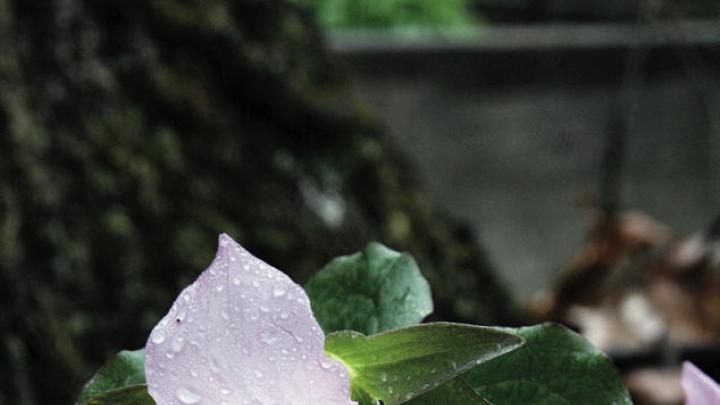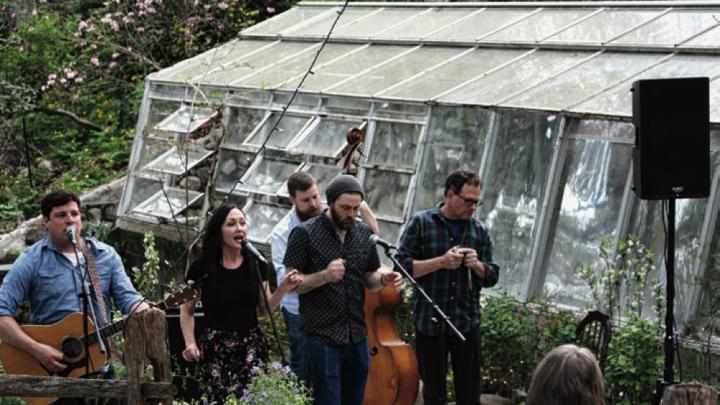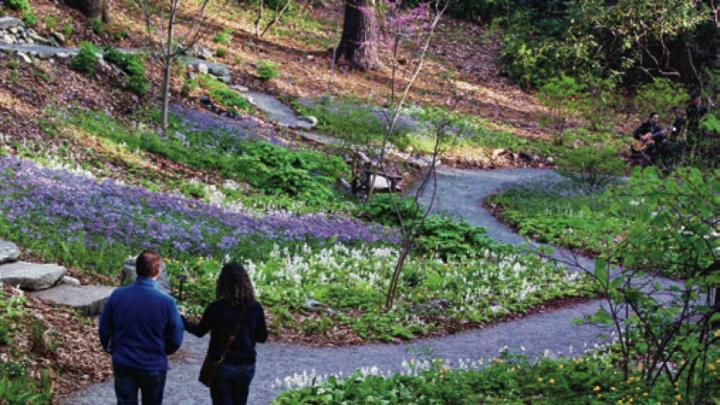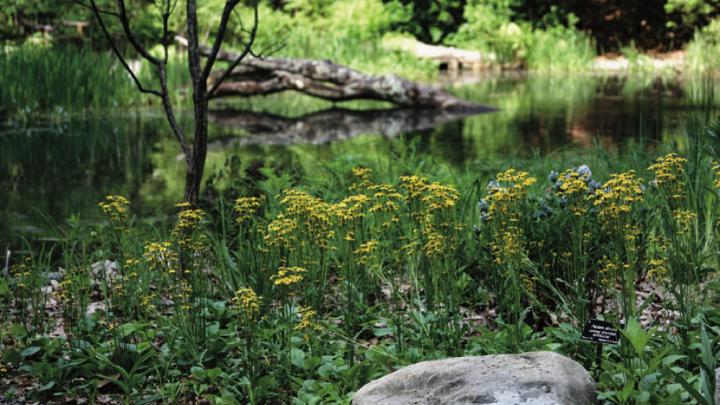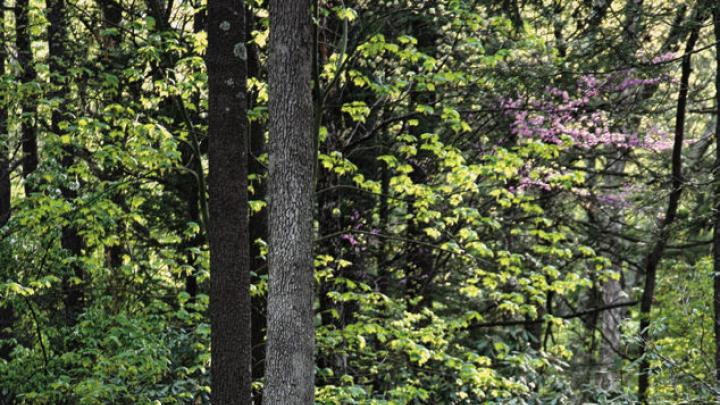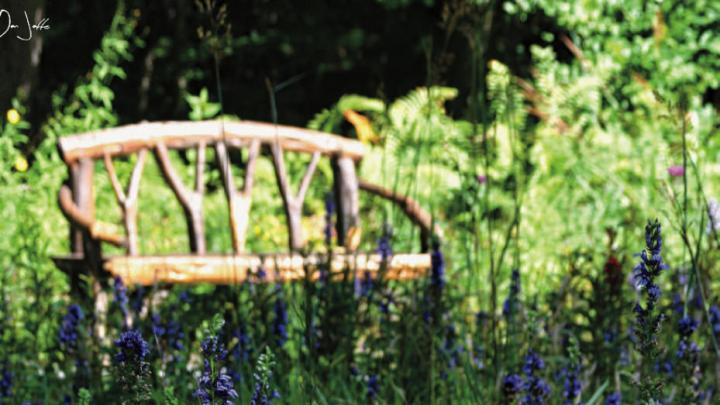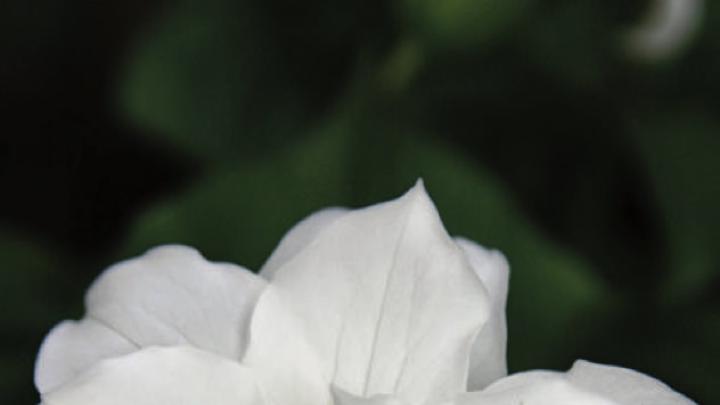Twenty miles from Boston, amid suburban sprawl, lies a 45-acre haven called Garden in the Woods. This “living museum” offers refreshing excursions through New England’s diverse flora and landscapes: visitors may roam woodland paths; explore a lily pond alive with painted turtles, frogs, and dragonflies; or take the outer Hop Brook Trail. Owned by the Native Plant Trust (the renamed New England Wild Flower Society), the Framingham sanctuary serves as both its headquarters and proof of its successful mission to conserve and promote regional native plants to foster healthy, biologically diverse environments. The organization also owns other botanical reserves in Maine, Vermont, and New Hampshire, and as a nursery, it produces more than 50,000 native plants annually, grown mostly from seeds found in the wild. Plants are grown primarily at its Nasami Farm, in Whately, Massachusetts, but plenty are cultivated from seeds in the greenhouse and stock beds at Garden in the Woods.
Plants and gathered seeds help restore native habitats and landscapes eroded by man-made or natural disasters: the visitor-trampled summit of Cadillac Mountain in Acadia National Park, for example, or the coastal destruction caused by Hurricane Sandy. The trust also operates a leading seed bank that is on track to collect seeds of “the 387 globally and regionally rare species in New England by 2020,” says executive director Debbi Edelstein, who leads a staff of 25, along with hundreds of devoted volunteer workers. The seed project is only part of its research support for horticulturists and botanists worldwide; more than 200 year-round regional educational programs are open to anyone, as are online resources, like Go Botany and Plantfinder, and information to help track endangered species and eliminate harmful invasives. “Plants are the foundation of all life. No matter what you want to conserve, whether the interest is in birds, bats, or bugs—they all depend on plants,” Edelstein adds. “But people tend to overlook them. People see something green and think it’s good, but they don’t really see the roles that very special individual species play in making everything else healthy.”
This growing season, a trip to Garden in the Woods might rectify that. There are places to picnic or relax, and a rustic playground for children, who can also try a do-it-yourself scavenger hunt to explore plants and creatures. Guided or self-guided tours, included with the cost of admission, route visitors through themed plantings—rock garden, coastal zone, meadow, extensive woodland garden—all designed and sustainably maintained to offer various bloom times and transformative colors and textural features from April 15 to October 15.
Trilliums are a spectacular springtime draw. The “quintessential, ephemeral woodland species are delicate, not only in the way they look, but in the way they grow,” explains horticulturalist Dan Jaffe, a principal propagator. “They are very susceptible to changes in habitat, and to being nibbled: the deer love them and trilliums can only handle so much before they succumb.”
The “tri” refers to three leaves per plant, three petals per flower, and three sepals, which resemble a cross between a leaf and a petal, says Jaffe, co-author of Native Plants for New England Gardens (2018): “At first they kind of look like a lollipop on a stick, curled into a ball shape, and then they pop up, and unfurl.” And they demand to be met on their own terms: “The unique survival trait that allows them to dwell in a forest with full trees is that they only come out when the New England light is high. Then the trees leaf out and there’s no more growing because there’s too much shade, and they go dormant for the rest of the year.”
Garden in the Woods has 26 trillium species—the largest collection north of Delaware. That fact, and the serene beauty of these early-spring risers, are celebrated during annual Trillium Week activities (May 5-11). Botanical tours and cultivation workshops, along with options to purchase plants from on-site propagation beds, culminate in a Friday evening of “Trilliums and Brews” with live music, craft beers, light fare, and strolls through the grounds. The flowers range from white to pinks, yellows, and a deep, maroon red; the leaves appear in matte, mottled, and variegated forms. The star of the show might be Trillium grandiflorum, a pristine white bloom that turns pink post-peak; Jaffe says scientists think this signals to pollinators, “The job’s been done; go find another flower.”
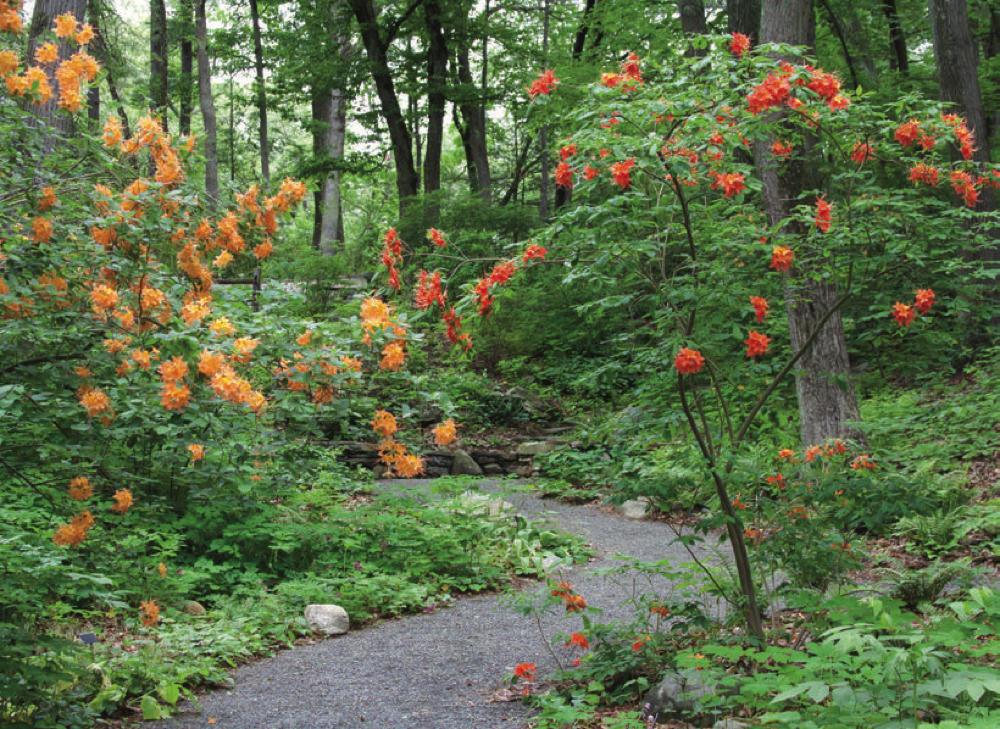
The sanctuary offers season-long botanical splendor, and lots of ideas for backyard landscaping with native plants.
Photograph courtesy of Native Plant Trust and Garden in the Woods/Photography by Dan Jaffe
It’s likely that the double-flowered white trillium (Trillium grandiflorum ‘multiplex’) was originally planted at Garden in the Woods by its founder, Will C. Curtis. In 1931 the landscape architect and lifelong plant collector bought 30 acres of the current Framingham site from the Old Colony Railroad, which had used it for mining gravel. The region was rural, and the property, with its topography and landscape of glacier-carved ridges, gullies, and brooks, captured his imagination. According to a 1991 American Horticulturist feature, Curtis was “eccentric and crusty”; although creating the garden became the focus of his life, “his abrasive personality alienated a series of volunteer helpers until he hired Howard O. ‘Dick’ Stiles.” Stiles had lost his job in the Depression, and “he too almost left, but Curtis—soft-hearted under that gruff exterior—persuaded him to stay, and the two became partners” in creating and maintaining the site.
They opened it to the public in the early 1930sas Garden in the Woods, a showcase for Curtis’s professional talents, naturalistic landscaping, and prized North American species. As Curtis aged, and encroaching postwar development brought new housing and the nation’s first mall, which opened nearby in 1951, he and concerned friends and garden-lovers mounted a nationwide campaign to raise money for an endowment. In 1965, Curtis donated the property to the then Wild Flower Preservation Society. He stayed on as director until he died, in 1969, at the age of 86, American Horticulturist reported; “his ashes were scattered among his beloved plants.”
In 2017, Native Plant Trust razed Curtis’s deteriorating cottage home on the property. But care was taken, Edelstein notes, to keep the foundation, two walls, a stone floor, and the skeleton of the old greenhouse. A small “cottage garden,” a work-in-progress this season, will creatively incorporate the “ruins.” Those features are part of the larger, revitalized Curtis Woodland Garden, where 20,000 new plants have been added during the last three years. As a tribute, the space spotlights some of Curtis’s favorite plants, and, therefore, “is the one place where we expand the plant palette to include species from the Piedmont and southern Appalachia regions,” notes Edelstein, along with a host of New England natives.
Among the new plants to watch for in the emerging cottage garden are maple-leaf viburnums and small-scale sourwood trees. The latter are “absolutely beautiful trees that bloom in mid-to-late summer,” Jaffe says, “with a series of dangling, long, bell-shaped flowers arranged almost like spikes.” In the fall, he adds, the “whole structure is covered with this shining bright red.” Sourwoods are also an ideal alternative to the highly invasive burning bush plants, which are illegal to sell in most New England states; Edelstein notes, “We want people to take it out of their gardens.”
Also of note this season is the garden’s “Kill Your Lawn” campaign, which highlights the cost of Americans’ lawn obsession—the use of pesticides and other chemicals, fossil-fueled maintenance machines, excessive water requirements, and destruction of healthy habitats—and offers alternatives. Jaffe enjoys the “native strawberry” solution. “Imagine a lawn, or come see ours, that requires no watering, mowing, or fertilizing,” he says. “Yet it still offers food for bees, butterflies, and humans while being capable of growing in some of the crappiest soils New England has to offer.”
Similar principles are in play at the meadow. Native annuals and a range of short- and long-life perennials enable the meadow gardens to change and grow over time, Jaffe points out. The woodland garden offers peak blooms in spring and early summer, but the meadow has more mid-to-late season appeal. Bee balm, Culver’s root, lobelia, and black-eyed Susan, among scores of other native species, bloom across the landscape, and in the fall, native grasses shine. The asters and goldenrods are the last to bloom, toward the end of the summer. “The rich darker colors come out—the oranges, bronzes, and browns,” he says. “There are rich hues of walnut and cherry. Brown has a bad reputation, and I’m trying to change that.”
The organization’s programs, meanwhile, explore native flora, micro-environments, and regional ecology. This season includes: “Orchids of New England,” with trust botanist Neela de Zoysa (Garden in the Woods, May 23); a landscape study of the Radcliffe Sunken Garden (Cambridge, May 31); and “Citizen Science with the Beecology Project,” with the effort’s co-leader, Worcester Polytechnic Institute research assistant professor Robert Gegear (Nasami Farm, June 23; and learn more about Beecology and Greater Boston bee projects in this issue).

The rarer lady’s slipper Cypripedium reginae
Photograph courtesy of Native Plant Trust and Garden in the Woods
Nasami Farm, near Northampton, opens for the season on April 27. It’s a fun day trip for those seeking to buy native plants from its nursery. But the trust’s other sanctuaries offer much more for visitors to explore. Edelstein recommends looking for “gorgeous ‘showy lady’s-slippers,’ wild orchids, and bog plants” this June at the 40-acre Eshqua Bog Natural Area, near Woodstock, Vermont, an area saved from development and owned jointly with the Vermont chapter of The Nature Conservancy. The much larger Hobbs Fern Sanctuary, in Lyman, New Hampshire, is home to more than 40 varieties of these lush, moisture-loving plants. In Woolwich, Maine, the Robert P. Tristram Coffin Wildlife Reserve encompasses 177 acres of sandy shores and tidal marshes—prime wetland-species habitat and a refuge for migratory and other shore birds, along with endangered pink lady’s-slippers. And this summer, farther up the Maine coast, stop into the Harvey Butler Rhododendron Sanctuary to explore these hardy New England flowering shrubs. Its grand, five-acre stand of great rosebay (Rhododendron maximum), Edelstein adds, typically explodes into bloom by mid July.
